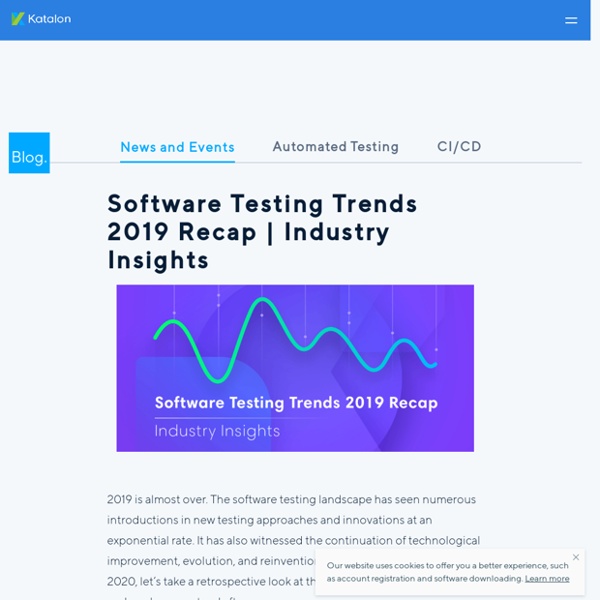Software Testing Trends 2019 Recap

https://www.katalon.com/resources-center/blog/recap-software-testing-trends-2019/
Related: allanwalker
• kornelia203
• jeffdunn
• brian2209
• tierney203
Katalon Smart Wait: A New Way to Handle Web Loading Issues
For those who are familiar with Selenium WebDriver, one of the most common features is the Wait command. These commands are handy in test scripts execution, or observing and troubleshooting issues that arise due to time lag. Wait commands are powerful — but they also come along with a big problem with timing due to front-end processing. Starting from version 7.0.0, we have introduced the Smart Wait feature that helps you handle Selenium wait issues without any additional test scripts. The #1 Selenium’s Villain: Timing Issue
Top Software Testing Trends to Watch Out For in 2020
The software testing landscape continues to evolve. We have seen the continuation of developing trends and the emergence of new trends in 2019. This year, our team of automation experts has cast a few predictions on the latest trends in the software testing industry. Check them out!
Desktop Application Testing with Katalon Studio 7
We’ve incorporated desktop application (app) testing to Katalon Studio — starting from version 7.0.0. This addition to the tool’s existing capabilities (web, API, and mobile testing) will transform Katalon Studio into a complete cross-platform test automation solution. See release notes here Katalon Studio for Desktop App Testing Starting from Katalon Studio 7, you can test desktop apps on Windows 10 PCs. Based on Windows Application Driver (WinAppDriver) service, Katalon Studio 7 supports Universal Windows Platform (UWP), Windows Forms (WinForms), Windows Presentation Foundation (WPF), and Classic Windows (Win32) apps.
7 Things to Know About the Brand New Katalon Studio 7
The brand new Katalon Studio 7 is here! Katalon Studio 7 (KS7) arrived with a host of enhanced features, promising to deliver an enjoyable automation experience and address the common challenges of the testing community. It also comes with new capabilities tailored for medium and large businesses’ needs.
Best 14 CI/CD Tools You Must Know
“Quality at Speed” is the new norm in software development. Enterprises are making their moves toward DevOps methodologies and Agile culture to accelerate the delivery speed and ensure product quality. In DevOps, a continuous and automated delivery cycle is the backbone that makes fast and reliable delivery possible.
CI/CD Pipeline: What, Why & How to Build The Best One
On this page: To gain full potential of the software development workflow, developers today must familiarize themselves with the best workflows, practices, and tools. Fast software production is no longer enough to win today’s technology marketplace. Deployments have to be faster, more reliable, and more accurate than the competitors.
Continuous Delivery vs. Continuous Deployment: Where to draw the line?
You’ve likely heard of the term CI/CD pipeline. You have probably known about these practices: continuous integration, continuous delivery, and continuous deployment as well. But the uncertainty remains: What are the differences between continuous delivery and continuous deployment?
What is Regression Testing? Definition, Tools & How to Get Started
What is regression testing? Regression testing is a software testing practice that ensures an application still functions as expected after any code changes, updates, or improvements. Regression testing is responsible for the overall stability and functionality of the existing features. Whenever a new modification is added to the code, regression testing is applied to guarantee that after each update, the system stays sustainable under continuous improvements. Changes in the code may involve dependencies, defects, or malfunctions. Regression testing targets to mitigate these risks, so that the previously developed and tested code remains operational after new changes.
Related:



